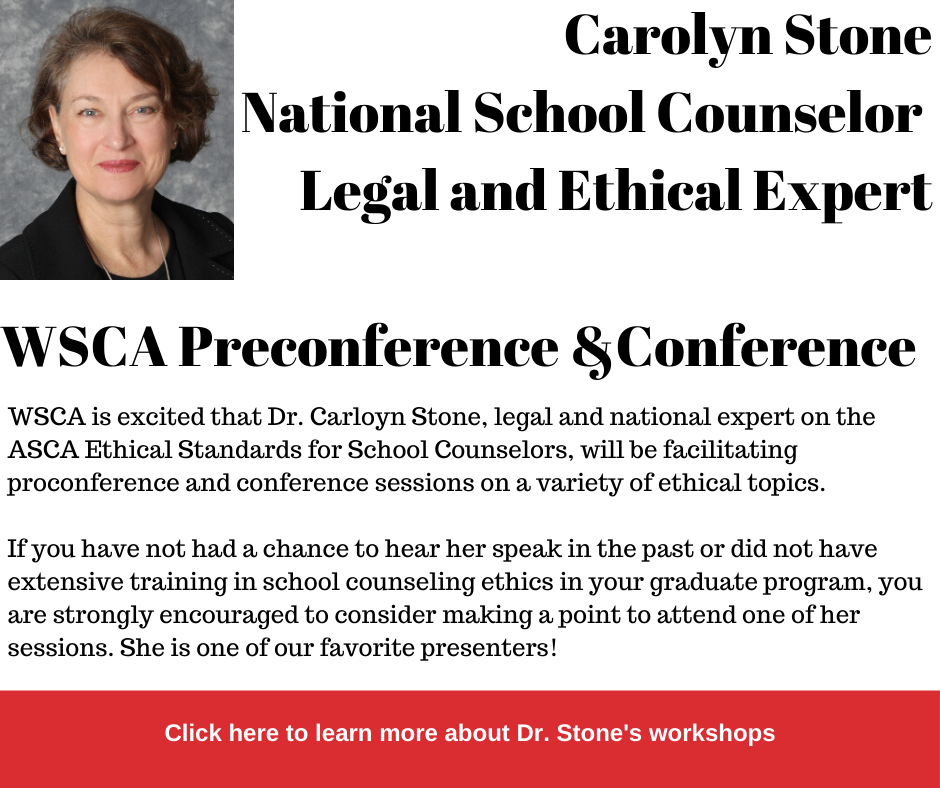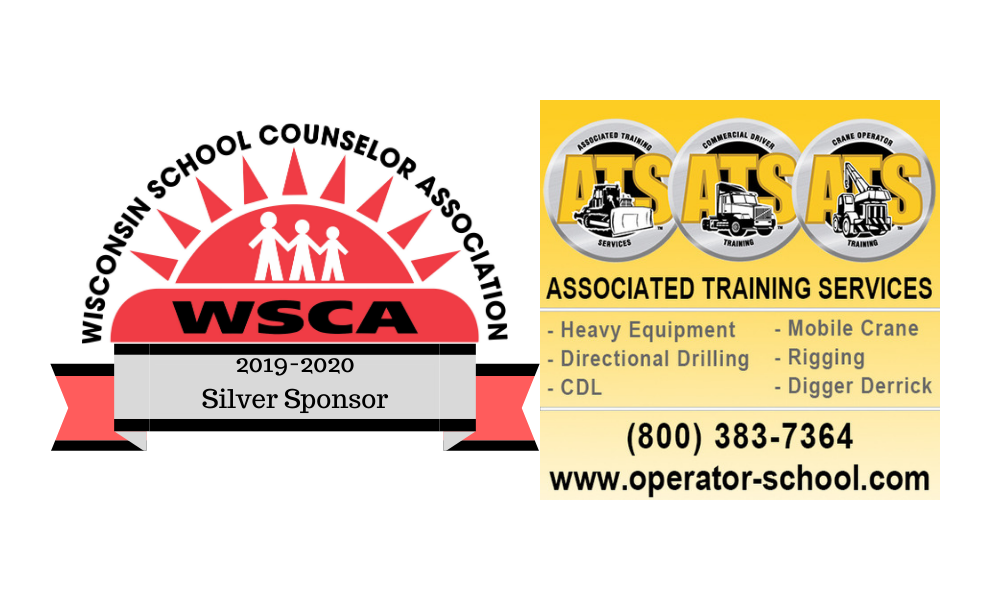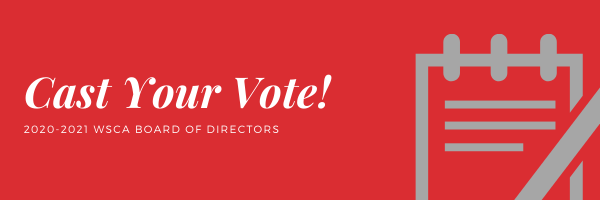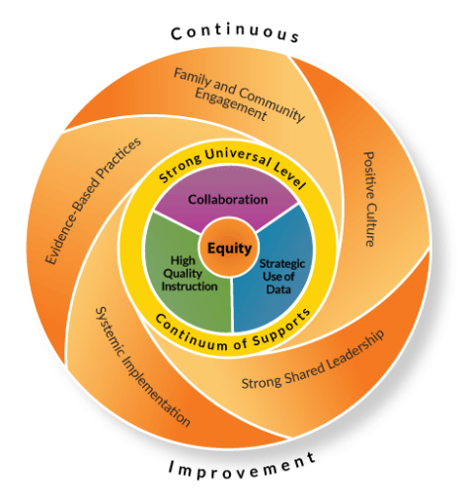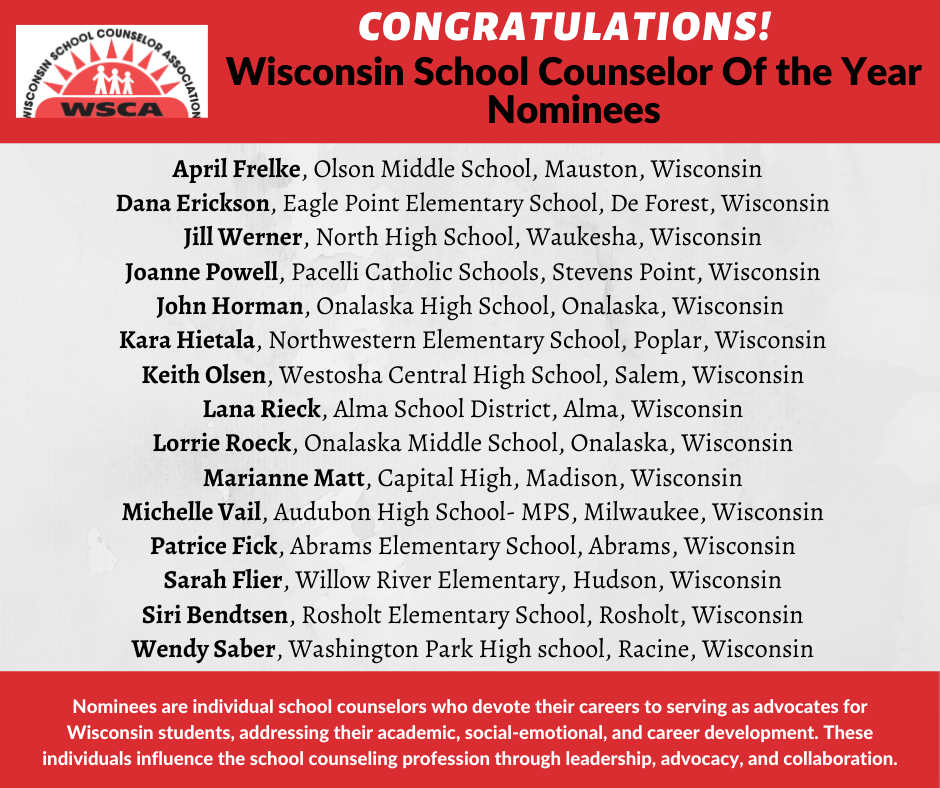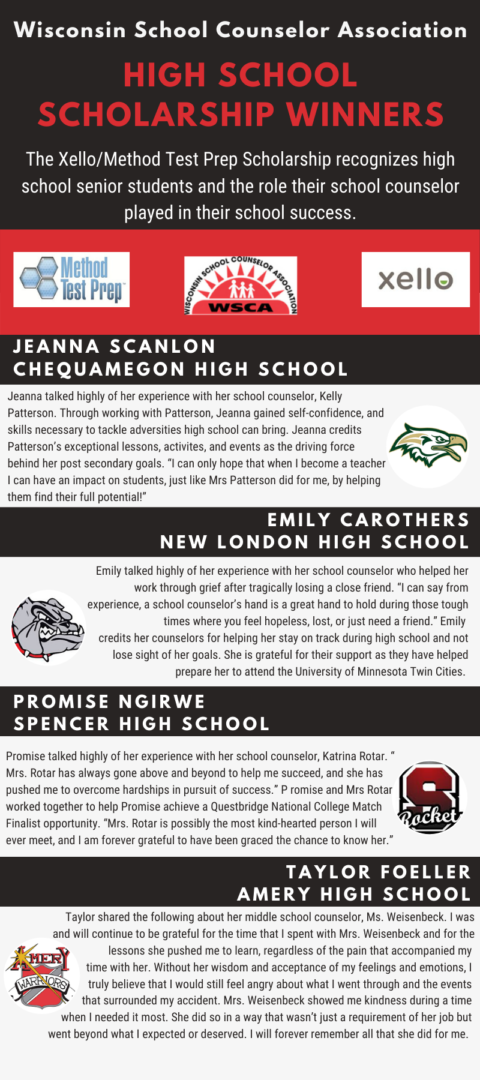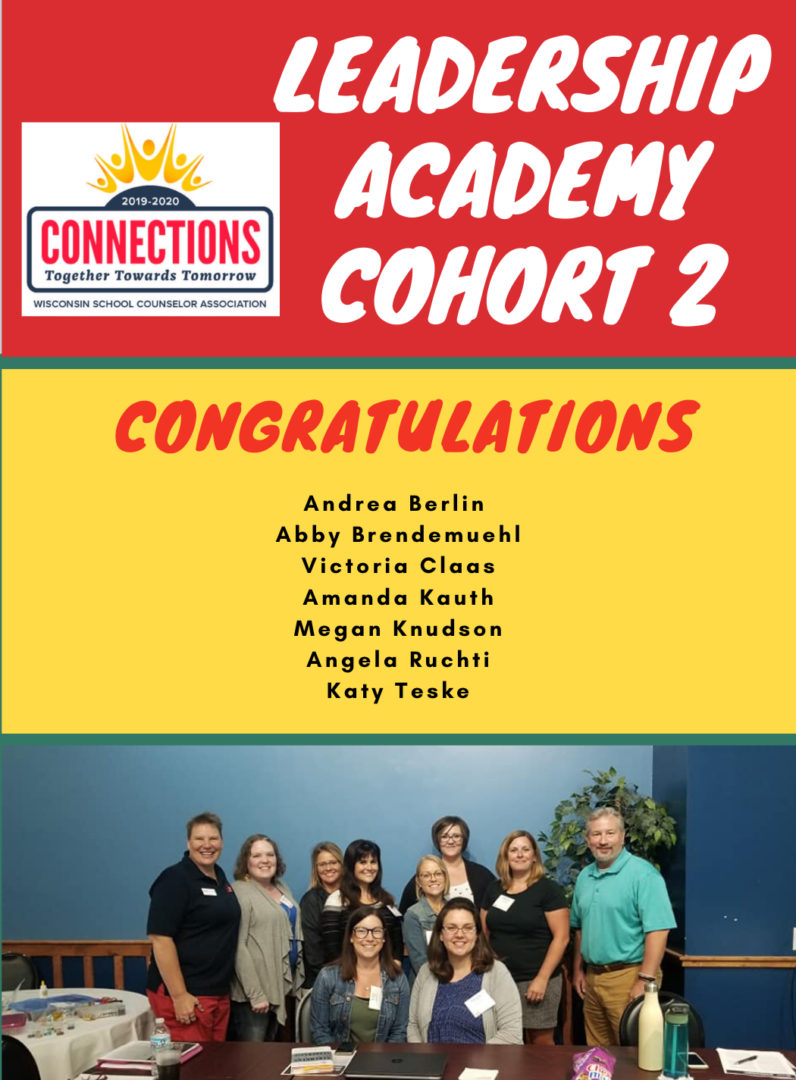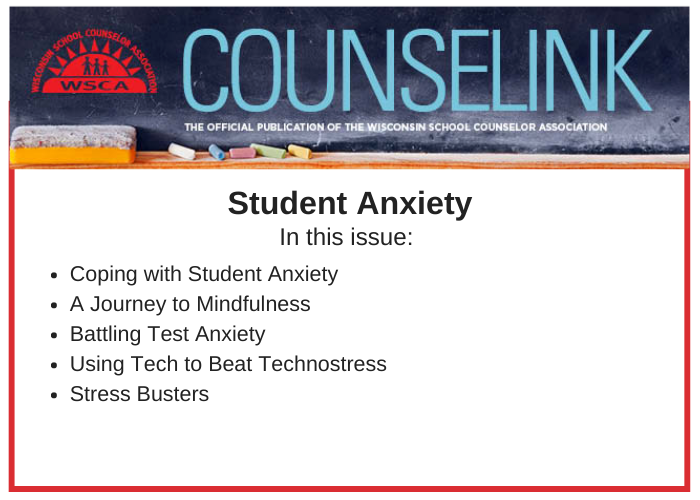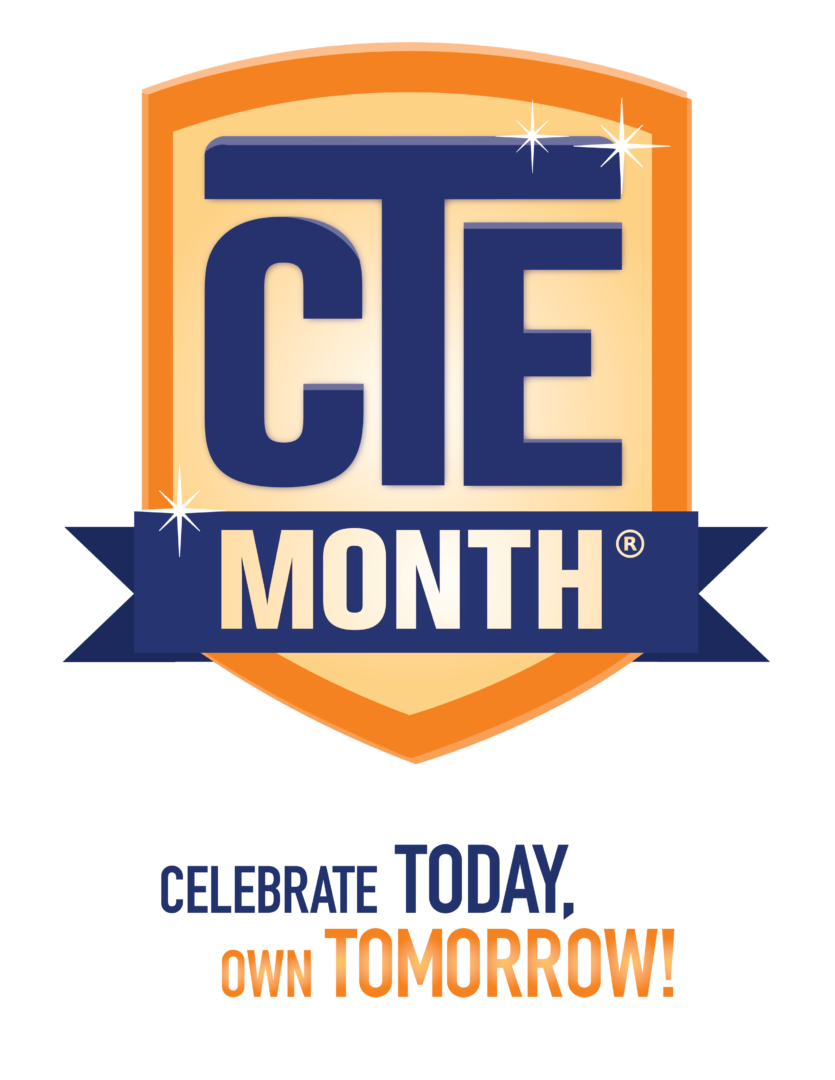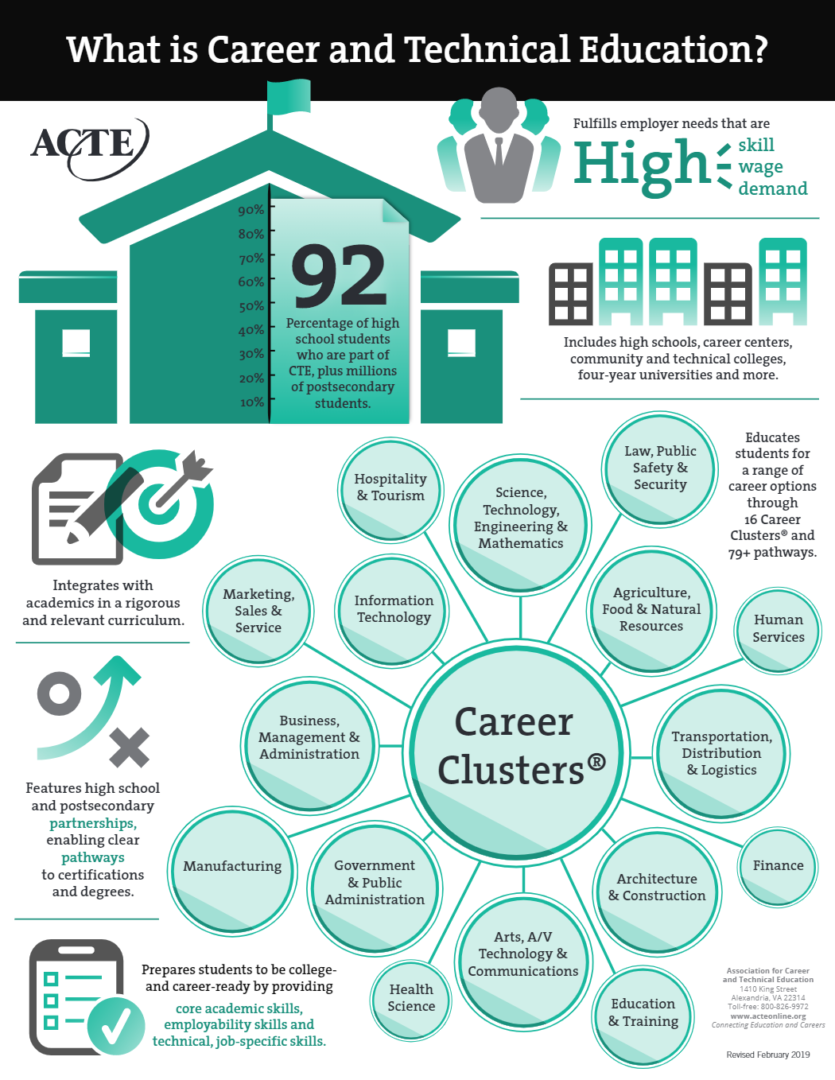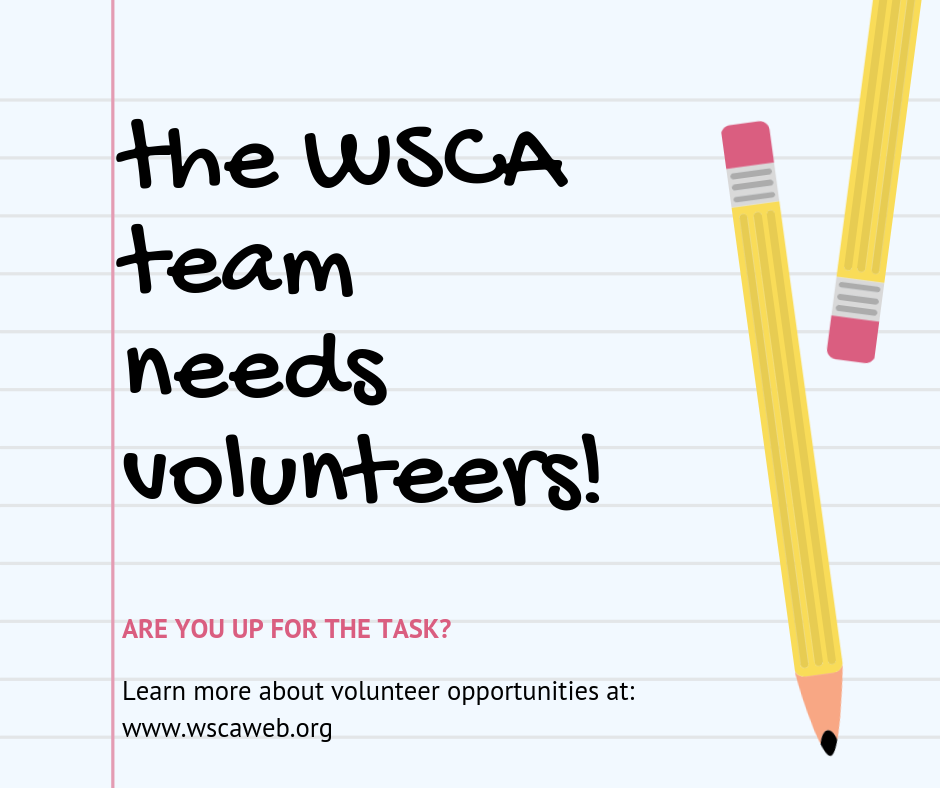February 2020

In This Issue:
A Message from the Executive Director – Connections: Together Towards Tomorrow
Carolyn Stone – Counselor Legal and Ethical Training Opportunities
A Message from the WSCA Board – Board Connection to ACP
2020-2021 Board Slate
Feature Article – Equity and the Populations We Serve
Special Sponsor Article – Teaching Children about Saving by Educators Credit Union
Legislative Update – Afternoon on the Hill
2019-2020 Conference
WSCA High School Xello/Method Test Prep Scholarship Winners
WSCA School Counselor of the Year Nominees
WSCA Ambassador Program
Leadership Academy
Counselink – Student Anxiety
National CTE Month
WSCA Volunteers Needed
A Message from the WSCA Executive Director
Connections: Together Towards Tomorrow
Stacy Eslick, WSCA Executive Director
The WSCA leadership team is excited that 50% of the school counselors in Wisconsin will be joining us next week at our annual conference! The focus of this year’s conference is “Connections: Together Towards Tomorrow”. As school counselors we understand the critical importance of building relationships (i.e., connections) and how through collaboration (i.e., together towards tomorrow) we do what is best for our students. We encourage our members to continue to build relationships and collaborate with counselors from across the state. It is amazing how much we have in common, let’s join together to support our profession as a whole so no one is feeling like they are alone in this work.
WSCA asks for input and feedback from our members to provide the professional development and resources you need. As a result of member input, WSCA is planning the following opportunities:
- WSCA is offering 18 conference sessions directly related to Equity! Thank you to the conference presenters, WSCA conference sectional review team and WSCA members for acknowledging the critical importance of equity in comprehensive school counseling programs.
- WSCA is creating Special Interest Groups (SIGs) to nurture the growing diversity in our association by providing “micro” communities within which members can network and add value to their WSCA membership experience. These smaller subsets of members are formed for the purpose of knowledge sharing and discussion among members with similar interests whether they are the specific subjects, issues or type of institution or students they serve.
- Adolescent Emotional Well Being
- Counselors of Color
- Early Career School Counselor
- Elementary School Counseling
- Retired and Active
- Rural and Small Town
The first meeting of WSCA Special Interest Groups (SIG’s) will be next week at conference (Thursday morning from 7:30-8:15). If you are not attending conference, look for more details on getting involved in a SIG in the March WSCAlink.
- WSCA is building a new team of regional representatives called WSCA Ambassadors. This will allow our organization to better understand counselor needs across the state as well as create local networks for WSCA members to collaborate and support each other. Ambassadors will: participate in monthly virtual WSCA Ambassador meetings; help plan regional NSCW breakfasts; communicate with local WSCA members; and host one annual regional social networking activity. To apply: http://tiny.cc/WSCAambassador
- WSCA continued our partnership with Ascendium Education Group (formerly Great Lakes Higher Education Corporation & Affiliates) and provided an Ascendium Fellow program (with an emphasis on rural counselors) for Fellows to build ongoing connections beyond conference! WSCA is the only State Counselor Association to offer this type of benefit to its members.
- WSCA is excited to continue our Leadership Academy program for next year. What we know from our members is that you have busy lives that make it hard to commit to the full Leadership Academy experience. In response to meet the needs of members that can’t participate in Leadership Academy, we are creating a virtual Introduction to Leadership program that will meet online 4-6 times during the 2020-2021 school year. Look for more details on how to register this spring!
While WSCA is very proud of having a nationally recognized conference, we also want our members to know that WSCA is more than just our conference. WSCA leadership has a Directors of Operations team that works tirelessly to support counselors across Wisconsin through professional development, advocacy and networking. The power of our association is through our members. Please join us in not only enjoying the amazing conference next week but get involved in the many other WSCA opportunities available to you so we can collectively build connections together towards a stronger tomorrow.
Stacy
A Message from the WSCA Board of Directors
WSCA Board and Academic and Career Planning
Donna Okray, School Counselor
Lincoln Center of the Arts, Milwaukee Public Schools
“Choose a job you love, and you will never have to work a day in your life.” ~Confucius
The WSCA Board of Directors operates using Policy Governance; a system of governance developed by John Carver that clearly delineates the roles and responsibilities of the Board distinctly from staff. The purpose of the Board, on behalf of the WSCA owners, is to ensure that WSCA: a) achieves appropriate results for appropriate persons at the appropriate value (as specified in Board Ends Policies and b) avoids unacceptable action s and situations (as prohibited in Board Executive Limitations Policies).
The WSCA Ends (Goals):
- Conditions exist so the Wisconsin School Counselors will practice with the highest level of effectiveness.
- School counselors (active and pre-service) will be knowledgeable about effective school counseling practices.
- School counselors are knowledgeable about the development, implementation and evaluation of comprehensive school counseling programs.
- School counselors are knowledgeable about current ethical and professional practices and their application.
- School counselors are knowledgeable about current trends in school counseling and education.
- School counselors are actively engaged in state and national initiatives that impact the school counseling profession.
- School counselors are knowledgeable about leadership and advocacy principles.
- School counselors are knowledgeable about equitable and culturally responsive practices.
- Key Stakeholders (including but not limited to) school administrators, policy makers, and community members will understand the impact made by the school counselor implementing a comprehensive school counseling program.
(Resource: WSCA Board Policy Governance Manual)Academic and Career Planning (ACP) has become an integral part of school counselors daily work. School Counselors are charged with providing support and services to students, parents, and school staff that encompasses ACP design and implementation. In the Milwaukee Public Schools District for the 2019-2020 school year, each school provides a formal process for individualized academic and career planning services for all students.
Schools incorporated at least 45-minutes of structured time every other week for ACP Advisory. During the ACP Advisory, the ACP Facilitator (teacher) leads students through Xello – My Plan which is the software tool students in grades 6-12 use to engage in academic planning, career planning, and exploration.
School Counselors serve as the ACP Coordinator within their buildings and lead an ACP Team to develop and implement a school-wide ACP Action Plan. The ACP Action Plan may include activities such as Xello – My Plan, College Campus Tours, and Pre-College Guest Speakers. MPS also offers other ACP activities that expose students to the 16 career clusters and College and Career Exploration such as Career Cluster Fair (grade 5), Dream Big Career Exploration (grade 8), and Work Readiness Sessions (grade 12).
For information about MPS ACP please visit: https://mps.milwaukee.k12.wi.us/en/Programs/School-Counseling/Academic-and-Career-Planning.htm.
There are several sectionals being offered at the 2019-2020 WSCA Conference with the theme of Academic and Career Planning.
Other helpful resources:
DPI ACP https://dpi.wi.gov/acp
WISELearn https://wlresources.dpi.wi.gov/
NACAC https://www.nacacnet.org/steps
DPI CTE https://dpi.wi.gov/cteThe WSCA Board of Directors is excited to present our Wisconsin School Counselor Association Board of Directors election slate for this year. The WSCA membership will vote for the slate of new Board Directors candidates with a ‘yes’ or ‘no’ vote during the month of February. If the membership votes are greater than 50% for “yes”, the election for our three new Board Directors will be complete. New Board Directors represent Wisconsin School Counselors for a three-year term beginning on July 1, 2020.
Before introducing more information about this year’s candidates, it’s important to review the criteria utilized by the WSCA Board to select these candidates. First, understand that the WSCA Board of Directors functions as owner representatives and servant leaders. The distinction between directors as occupational experts vs. servant leaders/owner representatives is especially important when it comes to elections. Slate candidates are not evaluated based solely on their school counseling expertise, but also their ability to serve in the role of a director. Understanding what qualities make an effective member of the WSCA Board of Directors is probably most easily accomplished by reviewing our “governing style” as defined in our Board Policy Manual:
Governing Style:
The Board will govern lawfully with an emphasis on:
- Outward vision rather than internal preoccupation.
- Encouragement of diversity in viewpoints.
- Strategic leadership more than administrative detail.
- Clear distinction of Board and Chief Executive roles.
- Collective rather than individual decisions.
- Future rather than past or present.
- Proactivity rather than reactivity.
The WSCA Board would like to thank all of this year’s applicants for making our job difficult. It was exactly the type of challenge we would hope our association would be faced with each year, and a great sign of the health of WSCA.
This year, the WSCA Board of Directors is excited to present the following slate of candidates to our owners for final approval:
- Tricia Norby: Tricia is a current WSCA Board member running for a second term on the Board, and is a practicing school counselor at St. James School in the Madison Diocese. A graduate of UW-Platteville, Tricia is in her 9th year of practice as a school counselor. She is also actively practicing as a private, licensed therapist. Tricia brings 3 years of experience on the WSCA Board, where she has actively participated in providing excellent leadership for the association. She is committed to the school counseling profession, holding it in high accord when stating in her application, “I believe in the voice of the school counselor as a leader in the schools, community, and government.”
- Amy Olson: Amy is a Lead School Counselor for the Madison Area School District, providing support and leadership for over 40 middle and high school counselors. She has been an active school counselor for the past 12 years, after graduating from the University of South Dakota in 2007. Amy is passionate about the importance of the school counseling profession, stating “we must have strong, knowledgeable leaders in the profession increasing our capacity as school counselors, increasing community awareness of our roles, and advocating on a state-wide level for all students to experience a comprehensive school counseling program during their time in K-12 education.”
- Carly Roth: Carly started her career as a school counselor 7 years ago at Thomas Edison HS in Fairfax County, Virginia. Since then, she has returned to Wisconsin and worked as a counselor for the Wauwatosa School District, and is currently practicing at Nicolet High School. Carly is a 2012 graduate of Marquette University. She is looking forward to serving our WSCA membership, stating in her application, “It’s important to hear from WSCA members in all school settings and placement levels in order to give the organization a strong sense of direction. Therefore, will be important to me as a leader to understand what school counselors in various settings need from their professional organization.”
All three of our slate candidates will be wearing a “candidate” ribbon at the annual conference. Please take the time to introduce yourself and ask any questions you might have of them. Then go vote!
The deadline to vote for the slate is February 29, 2020. You should have received an email allowing you to vote for the slate on February 3, 2020. If you did not receive an email, please contact the WSCA office at 608-204-9825.
Equity and the Populations We Serve
By: Jessie Sloan, Instructional Service Director and School Counselor, CESA 4
Academic and Career Planning is about providing equitable access to resources and experiences so ALL students, grades 6-12 within Wisconsin public schools, can prepare to be college, career, and life-ready. access and equitable experiences At any given time educators are tasked with 14 different initiatives and are asked to review specific populations that we serve. It is important for all educators to become grounded in defining equitable access and understanding the stories of the students/families that we serve. It is valuable for ACP teams to discuss the need to serve all students, rather than simply enforcing initiatives. When we look at those we serve on a human level, rather than as a whole group, we better serve everyone. That said, you will notice that I refer to individuals as heartbeats, by bringing us together and recognizing the value in the students/staff/families that we serve and their individual stories.
DPI and the RtI Center of Wisconsin have created two models to establish implementation of equity within school districts. These models can be used as a lens to examine a school district or personal beliefs in ACP, practices, policies, and interactions within the school community. The Equity Decision/Policy Tool created by DPI can be used by an ACP team or individual to initiate reflections or conversations about service towards the heartbeats that comprise our school community. I like to start with “Leading for Equity: In my interactions….” Ask yourself or ACP team members: how do I create a sense of belonging, how do I seek to understand diverse perspectives, how do I notice/respond to micro messages, and do I recruit racially diverse candidates? Next, be thoughtful of how these perspectives would be the same/different for the heartbeats in our school community (i.e. teen parents, students experiencing homelessness, LGBTQ, individuals within a minority race, disability, or English Learners…). Our school ACP activities and experiences should provide access for ALL heartbeats to have the opportunity to learn from the goals stated in our plans and have positive experiences.
The second model, created by the RtI Center of Wisconsin, is the Framework for Equitable Multi-Level Systems of Support. This framework can be applied to a district ACP by outlining the 11 Key Features to aspects of your plan (featured in the graphic below). By defining how the 11 Key Features are met within an ACP, schools will be able to identify areas of improvement, create common language and definitions. The Equitable Multi-Level Systems of Support also provides a means for schools to align multiple initiatives and speak to the heartbeats of the community about what is happening at school.
School Districts that utilize these models of equity can incorporate ACP goals that create positive school culture for all heartbeats! ACP teams may need to establish supports and professional development to understand and define special populations, Career Education data collection, and state and federal initiatives that can be incorporated into ACP for overall school improvement and positive school culture (i.e. PBIS, Trauma Sensitive Schools, Social Emotional Learning, Perkins V, State Endorsed Career Pathways, Career Clusters, and labor market needs…).
I look forward to the 2019-2020 WSCA Conference! Please visit the following sectionals to learn about school data collection and how Arcadia School District creates a positive ACP culture.
#32 WISEdata/WISEdash for District 101 for School Counselors, #78 Creating a Positive ACP Culture
A Special Sponsor Article
Teaching Children about Saving
Educators Credit Union
Many thanks to Educators Credit Union for the following information on teaching children about saving that can be shared with your families! Educators Credit Union also offers free resources on its website for post-high school planning and financial literacy https://www.ecu.com/financial-education-resource-library/.
Teaching Children About Saving
If you have children or grandchildren, or if you have a special relationship with your niece or nephew or the child of a dear friend, you can enrich their lives in many ways. One of the most important things you can teach is how to manage their money and invest for the future.The Three-Jar Allowance
To learn how to manage money, children need some money to manage, typically from an allowance you provide and eventually from doing small jobs for friends and neighbors. As a first step, you’ll have to decide how much the allowance should be and whether it should be linked to jobs they are required to do.As fair warning, both are matters of heated debate, so it’s worth doing some research and weighing what you’re comfortable with. For example, if you expect an older child to use some of the allowance for necessities, like clothing and school supplies, you may decide she needs a larger amount than if you’ll be paying those bills yourself. Whatever you decide, though, remember that the overall goal is to use the allowance as a way of teaching how to create a spending plan and live by it.
One popular suggestion, especially for younger children, is to illustrate the concept of budgeting by using three clear jars that represent current expenses, short-term savings, and long-term savings. Separating cash into jars makes it easy to compare the results of spending and saving. But don’t wait too long to open a savings account for their short-term savings and an investment account, such as a mutual fund, for their long-term account. Check with your bank or credit union about how to handle accounts for minors.
If you want to encourage charitable giving, you can use a fourth jar, set a fixed percentage of the total, such as 10%, and encourage putting money in that jar as well.
Spending V. Saving and Investing
To help children decide how much should go into spending and how much into saving, you can help them figure out how much they’ll need for regular weekly expenses, such as lunch money or whatever else you agree on. You might suggest keeping careful track of a week’s worth of spending and use that amount as a starting point. Part of the conversation should focus on the fact that budgeting always involves making adjustments. The goal isn’t to get it right the first time, but to come up with a workable allocation of money.Next, talk about money for short-term savings goals. Children’s goals vary substantially, based on their age and concept of time, but might include toys, sports equipment, electronic devices, special clothes, or other big-ticket items. You may want to suggest saving for one item at a time and help them figure out how much they’ll need to save each week to reach their goal in a realistic amount of time. But you’ll probably want to let them discover for themselves that not all goals are worth the time and effort it takes to reach them.
Finally,
be sure to encourage them to set aside a regular percentage for some long-term goal, however vaguely defined. For some children, saving for college means a lot. For others, the goal may be more tangible, like a car. Here, too, 10% of the total might be a reasonable percentage to save. As an incentive to put money into long-term savings, you might consider making a matching contribution by adding 50 cents or a dollar for every dollar your child puts in.
Sparking Interest in Investing
You may want to use common stocks to introduce your children to investing. Stocks are easy to explain and can be fun to track, especially if you start with companies that make products your children hold in high regards, like their favorite cereal, sports equipment, soft drink, or digital products. Once you show them how to track performance by going to the company website, or to general financial sites where they can find news stories about the company, it should be easy to get them involved.There are several ways to make investing come alive. One is to set up a hypothetical family account, either online or on paper, and track the ups and downs of the portfolio you choose together. Another is to “sell” each child some of your own shares. For example, if you’re planning to buy 200 shares of a particular company and you have two children, buy 202 and sell the extra shares to them at the price you paid.
You can keep track of the children’s shares in a separate register so they can follow what happens to their shares. (You should probably be willing to buy the shares back if they prove disappointing.) Finally, you might check giveashare.com, where you can buy single shares of a number of companies.
Opening Accounts for Children
If these approaches are too casual for you, or for your children, you can open separate accounts for them. You’ll have to decide on the mechanism, but there are several viable alternatives. Remember, you can give each child up to $15,000 in cash or other assets in 2018 without incurring gift taxes. If you’re married or have a partner, that person can also gift $15,000. That’s true of grandparents and other friends and relatives as well.You can open a guardian account for each child. In that case, you are the owner of the account although your child could make the decisions. Earnings are taxed at your rate.
You can also open a custodial account, either an UGMA (for Uniform Gifts to Minors Act) or UTMA (for Uniform Transfers to Minors Act). The child owns the account and you control it until he or she reaches the age of majority, usually 18 or 21, depending on the state. Taxable earnings are taxed at your rate until the child is 19 or 24 if he or she is a full-time student.
If your child has earned income, you can open a tax-deferred or tax-free Roth IRA in the child’s name. The contribution limit is $5,500 in 2018 or as much as the child earns if it is less than that amount.
One word of caution: If you want to teach your children valuable lessons about money, the keys are being committed to the approach you adopt and knowing what you want to accomplish by using it. Otherwise, it’s unlikely to work for very long, whatever your good intentions.
Governor Evers has called for a special session of the legislature to take up a plan to invest a portion of state surplus for funding in K-12 education. The bulk of the $250 million would go to increase special education funding and school property tax relief.A provision in the proposal is to provide $19 million GPR in additional school-based mental health services which expands the types of costs that are eligible for aid under the program to include school counselors, psychologists, or nurses. This provision is a result of the ongoing advocacy WSCA has been doing on behalf of our members.
PLEASE register today for the free WSCA Afternoon on the Hill event Tuesday, February 18thto meet in person with your legislator about the critical role school counselors play in mental health. YOUR stories and voice help educate legislators on our role in schools!
Not attending conference?
Information on how to reach your representative can be found at:/advocacy/government-relations-committee/


